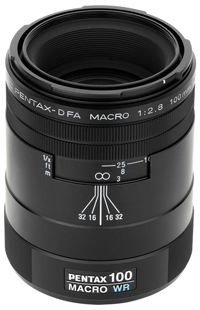Pentax-D FA 100mm F2.8 Macro WR
Macro Basics
On this page we will discuss characteristics that define a true macro lens such as the Pentax 100mm.
Magnification
The label "macro" is often applied to lenses that are not true macro, but which simply offer close focusing capabilities. A true macro is a lens that can create an image of the same size as the object it is looking at.
 True 1:1 Macro Reproduction
True 1:1 Macro Reproduction
For instance, with an APS-C sensor, an object 30mm long will fill the frame diagonally.
Magnification is calculated by taking the ratio of the subject and the image. A true macro will have a magnification of 1:1 or 1x, while a lens for which the image is half the size of the subject will have a magnification of 1:2 or 0.5x. Adding macro accessories such as extension tubes can increase the magnification above 1x.
Focal Length
The 100mm focal length has long been a sweet spot for macro lenses. The well-regarded manual Vivitar Series 1 105mm f2.5 and 100mm f2.8 and the Lester A. Dine 105mm f2.8 Macro dentist kit are two stellar examples. Pentax has almost always had a 100mm macro lens in its lineup.
Still, it is far from being the only useful focal length available for macro. What are the advantages of longer or shorter focal lengths?
A lens such as the D FA 100mm macro has two main advantages over shorter focal lengths. The first is that it allows more distance between the subject and the camera for a given magnification. This is especially useful when photographing live subjects such as insects, but also applies to small objects in general. More distance helps to prevent shadows created by the photographer or the equipment and avoids scaring off live subjects.
 Shallow depth of field
Shallow depth of field
The second advantage is that, all things being equal, a longer focal length will allow narrower depths of field to be obtained, which leads to better subject isolation. However, this is not always an advantage, and macro shooters often work at F8 or smaller apertures in order to increase the DOF. Because of this, a 50mm or even 35mm macro lens can be more desirable. A 50mm is also easier to hold by hand than a 100mm.
 Image taken handheld with a 50mm lens
Image taken handheld with a 50mm lens
A shorter focal length can also bring an interesting, uncommon perspective to an image, such as this one taken with a (non macro) 21mm Limited.
 21mm perspective
21mm perspective
Macro lenses often serve more than one purpose, and this should be kept in mind when selecting a lens. A 100mm can double as a short telephoto lens. A 50mm doubles as an excellent portrait lens. A 35mm, especially the Pentax Limited, can serve as a compact and reliable walkaround lens.


